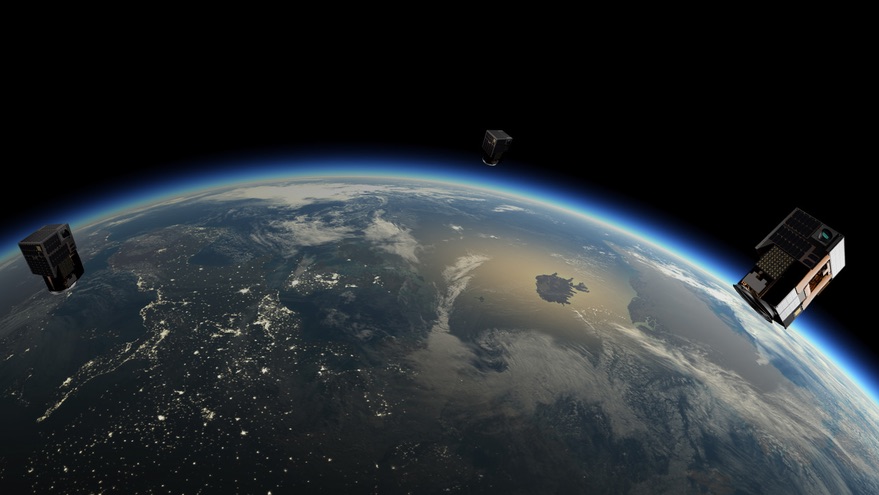WASHINGTON — As Satellogic prepares to launch its latest imaging satellites, the company has slashed revenue projections, resulting in layoffs and delays in construction of a new factory.
Four NewSat satellites, built by Satellogic, are among the 114 payloads to be launched on SpaceX’s Transporter-6 dedicated smallsat rideshare mission. That mission is scheduled to launch Jan. 3 at 9:56 a.m. Eastern on a Falcon 9 from Cape Canaveral Space Force Station in Florida. Satellogic signed a contract with SpaceX in May 2022 to launch 68 satellites on an unspecified number of launches.
The four satellites will join 26 currently in operation by Satellogic that provide high-resolution imagery. The company, in a business update Dec. 15, said it expected to launch 18 to 21 satellites in 2023, giving it enough satellites to map the Earth every two weeks.
That business update, which included the company’s financial results from the first half of 2022, showed revenue lagging earlier projections. The company recorded $2.4 million in revenue in the first half of the year, primarily from two unnamed customers, according to filings with the Securities and Exchange Commission.
Satellogic said in its business update it was projecting revenues of $6-8 million for all of 2022, and an adjusted earnings before interest, taxes, depreciation and amortization (EBITDA) loss of $55-60 million. By contrast, in an analyst day presentation in November 2021, part of going public through a SPAC merger, Satellogic projected revenue of $47 million for 2022 and an adjusted EBITDA loss of $2 million.
Emiliano Kargieman, chief executive of Satellogic, acknowledged he was “disappointed” with the revenue from the first half of the year, but remained optimistic about the company’s long-term trajectory, citing an increase in demand for its imagery seen in the second half of the year. “Our bookings and current pipeline support continued strong growth into 2023,” he said in a Dec. 15 earnings call.
The company, which in November 2021 projected revenues of $132 million in 2023, growing to $787 million in 2025, now projects $30-50 million in revenues in 2023, increasing to $140-200 million in 2025. Satellogic projects an adjusted EDBITA loss of $20-35 million in 2023, reaching breakeven in 2024 and growing to positive $35-90 million in 2025.
Kargieman said the company now has a better idea of the sales cycle for its imagery and other products. “After another year of talking to customers, we’re extremely confident in the numbers that we’re guiding for next year,” he said.
The diminished revenues have forced the company to cut costs. That included laying off 18% of its workforce in the third quarter, reducing its staff to about 380 people. Rick Dunn, Satellogic’s chief financial officer, said the number of employees would remain “more or less flat” in 2023.
The company has also scaled back the growth of its constellation. In that November 2021 presentation, Satellogic projected having 111 satellites in orbit in 2023. The company will instead end 2023 with no more than 47 satellites, although Kargieman said in the call that some of the 10 satellites it launched in October 2020 could be retired by the end of 2023 as they reach the end of their three-year design life.
With those reduced projections, Satellogic has delayed completion of a new high-throughput satellite manufacturing facility it planned to open in 2022 in the Netherlands. That factory, which Satellogic said in late 2021 would be fully operational by the start of 2023, was designed to produce 25 satellites a quarter.
Kargieman said the company’s existing factory in Uruguay can produce 24 satellites a year, sufficient for its near-term needs. “Going forward, we can continue to grow that capacity,” he said, increasing it potentially by a factor of two or three. The Dutch factory will go into service when the company is ready to scale up the constellation to the 300 satellites needed for daily remapping of the Earth. “The exact timing is yet to be defined.”
Satellogic is now offering to sell satellites, rather than just imagery, to customers. Dunn projected that at least 25% of the company’s revenues in 2023 would come from this new “space systems” business line, although weighted towards the second half of the year.
The rest of the company’s revenues will continue to come from imagery sales as well as its “constellation as a service” or dedicated satellite constellation business line, where governments and other organizations pay to gain priority access to Satellogic’s constellation over a designated area. One example Kargieman cited was an agreement with the government of Albania announced in September to provide imagery over its territory. The three-year deal is worth $6 million and includes naming two NewSat satellites launching on Transporter-6 Albania-1 and -2.
Satellogic announced Dec. 13 a letter of intent with the Mexican space agency AEM for a similar constellation-as-a-service agreement, but the company did not disclose when the contract would be finalized or its anticipated value. However, the Indian space agency ISRO announced Dec. 30 that it met with AEM officials, who asked ISRO for assistance in building and launching a remote sensing satellite.
Satellogic, which raised $168 million when its SPAC merger closed in January 2022, projected having $78-82 million of cash on hand at the end of 2022. That is enough, Kargieman said, to get the company to breakeven in 2024. “We don’t require additional financing,” he said. “We’re really in control of how much we spend and how much we invest into our future business, so we don’t expect to be raising additional financing.”
